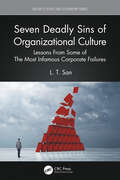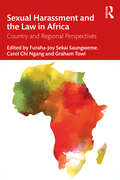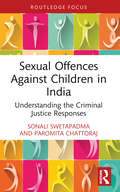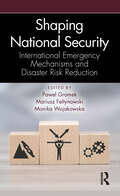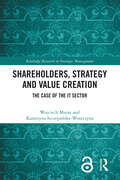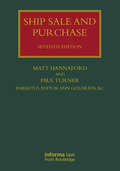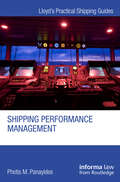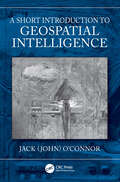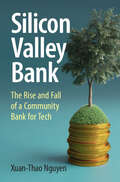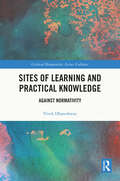- Table View
- List View
Seven Days: a gripping, high-octane crime thriller for 2024 - can Alice save her father from death row?
by Robert Rutherford'Wow! An absolutely fantastic edge of your seat thriller. I could not turn the pages fast enough... Would be an amazing film or tv series. The ending was perfect... Highly recommended' Reader review⭐⭐⭐⭐⭐Your father is on death row. You have seven days to save him. But do you want to?Alice knows her father is guilty of many things. He's guilty of abandoning her.He's guilty of being unfaithful to her mother.But is he guilty of murder?Now on Death Row, he has seven days to live.Some people want him released.Others will kill to keep him just where he is.Alice has only one chance to save him. But should she?Readers are loving Seven Days:'This was wild! Really enjoyed this. Good characters, good story line and it kept me guessing' Reader review⭐⭐⭐⭐⭐'Compulsive and page turning read... lots of surprises' Reader review⭐⭐⭐⭐⭐'A dark and atmospheric thriller that explores the complexities of family, trauma, and life, with a shocking ending, fantastic novel'⭐⭐⭐⭐⭐'Twisty, tense and superbly characterised, this global race against time and across the world is a top read'⭐⭐⭐⭐⭐'Kept me hooked from start to finish!'⭐⭐⭐⭐⭐'A high-octane, high-stakes thriller about family dynamics, guilt and responsibility'⭐⭐⭐⭐⭐
Seven Deadly Sins of Organizational Culture: Lessons From Some of The Most Infamous Corporate Failures (Security, Audit and Leadership Series)
by L. T. SanThis book is about the primary symptoms present in a dysfunctional culture that could have devastating outcomes for any organization. The book outlines each of the seven sins in each chapter. Each of the first seven chapters (Chapters 1–7) starts with a famous quote related to each of the sins and then immediately recounts stories ripped from the headlines describing well-known corporate failures but with a personal touch from former employees who experienced those stories from inside the company. (The sources for these stories are all cited in their Bibliographies.) The seven sins of organizational culture are linked with seven different corporate scandals that serve as a "lesson learned" as well as seven stories of organizations that have been successful with each respective organizational attribute as follows: Flawed Mission and Misaligned Values uses WorldCom as the lesson learned and Patagonia as the success case. Flawed Incentives uses Wells Fargo as the lesson learned and Bridgeport Financial as the success case. Lack of Accountability uses HSBC as the lesson learned and McDonald’s as the success case. Ineffective Talent Management uses Enron as the lesson learned and Southwest Airlines as the success case. Lack of Transparency uses Theranos as the lesson learned and Zappos as the success case. Ineffective Risk Management uses the 2008 mortgage industry collapse as the lesson learned and Michael Burry as the success case. Ineffective Leadership summarizes all of the foregoing sins as failures of Leadership. In each chapter and for each organizational sin, the author offers seven attributes of a healthy culture to counter the cultural dysfunction. The seven healthy attributes for each of the seven sins are all original content. In Chapter 8, the author offers an approach for assessing an organization’s culture by providing seven ways to measure the different drivers of organizational culture. The ideas for how to measure corporate culture is original content, with some references to existing frameworks (all cited in the Bibliography.) Finally, in Chapter 9, the author offers a step-by-step outline for transforming the culture. The chapter starts with a story about how Korean Air suffered multiple crashes due to their corporate culture but were able to successfully transform their culture. (The source for the Korean Air story is cited in the Bibliography.) There are seven appendices, most of which are by the author except for the maturity of risk management, which references an OECD (government entity) risk management maturity framework.
Seven Deadly Sins of Organizational Culture: Lessons From Some of The Most Infamous Corporate Failures (Security, Audit and Leadership Series)
by L. T. SanThis book is about the primary symptoms present in a dysfunctional culture that could have devastating outcomes for any organization. The book outlines each of the seven sins in each chapter. Each of the first seven chapters (Chapters 1–7) starts with a famous quote related to each of the sins and then immediately recounts stories ripped from the headlines describing well-known corporate failures but with a personal touch from former employees who experienced those stories from inside the company. (The sources for these stories are all cited in their Bibliographies.) The seven sins of organizational culture are linked with seven different corporate scandals that serve as a "lesson learned" as well as seven stories of organizations that have been successful with each respective organizational attribute as follows: Flawed Mission and Misaligned Values uses WorldCom as the lesson learned and Patagonia as the success case. Flawed Incentives uses Wells Fargo as the lesson learned and Bridgeport Financial as the success case. Lack of Accountability uses HSBC as the lesson learned and McDonald’s as the success case. Ineffective Talent Management uses Enron as the lesson learned and Southwest Airlines as the success case. Lack of Transparency uses Theranos as the lesson learned and Zappos as the success case. Ineffective Risk Management uses the 2008 mortgage industry collapse as the lesson learned and Michael Burry as the success case. Ineffective Leadership summarizes all of the foregoing sins as failures of Leadership. In each chapter and for each organizational sin, the author offers seven attributes of a healthy culture to counter the cultural dysfunction. The seven healthy attributes for each of the seven sins are all original content. In Chapter 8, the author offers an approach for assessing an organization’s culture by providing seven ways to measure the different drivers of organizational culture. The ideas for how to measure corporate culture is original content, with some references to existing frameworks (all cited in the Bibliography.) Finally, in Chapter 9, the author offers a step-by-step outline for transforming the culture. The chapter starts with a story about how Korean Air suffered multiple crashes due to their corporate culture but were able to successfully transform their culture. (The source for the Korean Air story is cited in the Bibliography.) There are seven appendices, most of which are by the author except for the maturity of risk management, which references an OECD (government entity) risk management maturity framework.
Sex, Gender and International Human Rights Law: Contesting Binaries (Feminist and Queer International Law)
by Giovanna GilleriThis book investigates the relationship between sex and gender under international human rights law, and how this influences the formation of individual subjects. Combining feminist, queer, and psychoanalytical perspectives, the author scrutinises the sexed/gendered human rights discourse, starting from the assumptions underpinning interpretations of sex, gender, and the related notions of gender identity, sex characteristics, and sexual orientation. Human rights law has so far offered only a limited account of the diversity of sexed/ gendered subjectivities, being based on a series of simplistic assumptions. Namely, that there are only two sexes and two genders; sex is a natural fact and gender is a social construct; gender is the metonymic signifier for women; and gender power relations take the asymmetrical shape of male domination versus female oppression. Against these assumptions, dominative and subordinate postures interchangeably attach to femininities and masculinities, depending on the subjects’ roles, their positionalities, and the situational meanings of their acts. The limits of an approach to gender which is based on rigid binaries are evident in two case studies, on the UN human rights treaty bodies’ vocabulary on medically unnecessary interventions upon intersex children and on the European Court of Human Rights’ narrative on sadomasochism. This examination of the impact of human rights on gendered subjectivities will be of interest to scholars, students, and researchers in international law, gender studies, queer studies, cultural studies, critical race theory, and psychoanalysis.
Sex, Gender and International Human Rights Law: Contesting Binaries (Feminist and Queer International Law)
by Giovanna GilleriThis book investigates the relationship between sex and gender under international human rights law, and how this influences the formation of individual subjects. Combining feminist, queer, and psychoanalytical perspectives, the author scrutinises the sexed/gendered human rights discourse, starting from the assumptions underpinning interpretations of sex, gender, and the related notions of gender identity, sex characteristics, and sexual orientation. Human rights law has so far offered only a limited account of the diversity of sexed/ gendered subjectivities, being based on a series of simplistic assumptions. Namely, that there are only two sexes and two genders; sex is a natural fact and gender is a social construct; gender is the metonymic signifier for women; and gender power relations take the asymmetrical shape of male domination versus female oppression. Against these assumptions, dominative and subordinate postures interchangeably attach to femininities and masculinities, depending on the subjects’ roles, their positionalities, and the situational meanings of their acts. The limits of an approach to gender which is based on rigid binaries are evident in two case studies, on the UN human rights treaty bodies’ vocabulary on medically unnecessary interventions upon intersex children and on the European Court of Human Rights’ narrative on sadomasochism. This examination of the impact of human rights on gendered subjectivities will be of interest to scholars, students, and researchers in international law, gender studies, queer studies, cultural studies, critical race theory, and psychoanalysis.
Sexual Harassment and the Law in Africa: Country and Regional Perspectives
by Furaha-Joy Sekai Saungweme Carol Chi Ngang Graham TowlWritten by a team of experts from legal, forensic, and policy backgrounds, this book presents new research into sexual violence and harassment across Africa.This first of it's kind book foregrounds the work of African scholars and presents careful research analysis and case studies that consider sexual harassment from legal, socio-economic, and cultural realities. It highlights the importance of laws around sexual harassment in Africa, the intersectional challenges it poses to women in the workplace, and the role of the feminist movement in Africa to hold perpetrators accountable and give voice to survivors of sexual harassment. The book forms part of a broader African-driven research initiative on sexual harassment and the law and is written in partnership with the Africa End Sexual Harassment Initiative (AESHI). It also explores the need to focus on best-practice benchmarks for Africa and also learning from developments in Africa.Timely and relevant, the book will be of great interest to legal and policy academic scholars, professionals, and activists working in the fields of gender policy, forensic psychology, and NGOs. It will also be useful reading for postgraduate students of law, gender studies, political science, and African studies.
Sexual Harassment and the Law in Africa: Country and Regional Perspectives
by Furaha-Joy Sekai Saungweme Carol Chi Ngang Graham TowlWritten by a team of experts from legal, forensic, and policy backgrounds, this book presents new research into sexual violence and harassment across Africa.This first of it's kind book foregrounds the work of African scholars and presents careful research analysis and case studies that consider sexual harassment from legal, socio-economic, and cultural realities. It highlights the importance of laws around sexual harassment in Africa, the intersectional challenges it poses to women in the workplace, and the role of the feminist movement in Africa to hold perpetrators accountable and give voice to survivors of sexual harassment. The book forms part of a broader African-driven research initiative on sexual harassment and the law and is written in partnership with the Africa End Sexual Harassment Initiative (AESHI). It also explores the need to focus on best-practice benchmarks for Africa and also learning from developments in Africa.Timely and relevant, the book will be of great interest to legal and policy academic scholars, professionals, and activists working in the fields of gender policy, forensic psychology, and NGOs. It will also be useful reading for postgraduate students of law, gender studies, political science, and African studies.
Sexual Offences Against Children in India: Understanding the Criminal Justice Responses (Routledge Frontiers of Criminal Justice)
by Sonali Swetapadma Paromita ChattorajSexual Offences Against Children in India examines the evolution of the law pertaining to sexual violence against children, the judicial decisions since the inception of the POCSO Act till date with respect to aspects of the POCSO Act and the best practices from other developed jurisdictions for handling cases and victims of child abuse.Despite being prevalent, violence against children is often hidden or underreported, though its impact is widely acknowledged. In a country like India the vocabulary to communicate around sexuality and sexual abuse is almost non-existent. India has seen its journey from having no law on sexual abuse of children to having a “special” law in the form of the Protection of Children against Sexual Offences Act 2012 (POCSO Act). This book demystifies the problem of sexual violence against children in India pre- and post-POCSO Act. There is also a novel attempt to examine the implementation of the POCSO Act in the eastern Indian states of Odisha, Jharkhand and West Bengal, and if its objectives were being attained – in content, in implementation, and in impact.This book will be useful for police, judiciary and government officials, scholars, and researchers studying comparative aspects of dealing with sexual offence cases against children.
Sexual Offences Against Children in India: Understanding the Criminal Justice Responses (Routledge Frontiers of Criminal Justice)
by Sonali Swetapadma Paromita ChattorajSexual Offences Against Children in India examines the evolution of the law pertaining to sexual violence against children, the judicial decisions since the inception of the POCSO Act till date with respect to aspects of the POCSO Act and the best practices from other developed jurisdictions for handling cases and victims of child abuse.Despite being prevalent, violence against children is often hidden or underreported, though its impact is widely acknowledged. In a country like India the vocabulary to communicate around sexuality and sexual abuse is almost non-existent. India has seen its journey from having no law on sexual abuse of children to having a “special” law in the form of the Protection of Children against Sexual Offences Act 2012 (POCSO Act). This book demystifies the problem of sexual violence against children in India pre- and post-POCSO Act. There is also a novel attempt to examine the implementation of the POCSO Act in the eastern Indian states of Odisha, Jharkhand and West Bengal, and if its objectives were being attained – in content, in implementation, and in impact.This book will be useful for police, judiciary and government officials, scholars, and researchers studying comparative aspects of dealing with sexual offence cases against children.
Shaping National Security: International Emergency Mechanisms and Disaster Risk Reduction
Shaping National Security: International Emergency Mechanisms and Disaster Risk Reduction presents international emergency mechanisms relative to disaster risk reduction (DRR). The goal is to share knowledge about existing frameworks, and utilize established DRR policies and programs, as another means to reinforce and strengthen national security in countries around the world. The book outlines, in detail, the United Nations Disaster Assessment and Coordination (UNDAC), the International Search and Rescue Advisory Group (INSARAG), the North Atlantic Treaty Organisation (NATO) and the Union Civil Protection Mechanism (UCPM) DRR programs. While these entities’ versions of DRR best practices are largely directed at decreasing the impact of disaster hazards, limiting relevant exposure, local vulnerabilities, increasing capacities to cope with disaster, the authors present these frameworks as potential tools, and effective means, to support national security efforts. This is especially important in disaster circumstances when local, and national emergency resources, may be insufficient to face hazards and multi-hazards, and result in cascading effects to occur as hazard events transpire. Chapters present various resources available to them, through these programs, to encourage authorities from every country to effectively apply the mechanisms—and emergency mechanisms specifically—to offer domestic solutions. Due to these programs proven track records in providing organisational standards, the use of such mechanisms can serve as both the basis to foster sound DRR practices and, by extension, can supplement resiliency, security, and continuity within countries. This concept is based on the premise that the UNDAC, INSARAG, NATO and ECPM emergency mechanisms have been developed to be implementable (directly or indirectly) in every country in the world when disasters occur. Shaping National Security takes a "big-picture," holistic view of DRR and national security to offer innovative ideas and solutions to professionals and officials working in disaster management, disaster risk reduction, emergency management, crisis management, civil protection, public security management, national security, criminal justice, international studies, and homeland security.
Shaping National Security: International Emergency Mechanisms and Disaster Risk Reduction
by Pawel Gromek Mariusz Feltynowski Monika WojakowskaShaping National Security: International Emergency Mechanisms and Disaster Risk Reduction presents international emergency mechanisms relative to disaster risk reduction (DRR). The goal is to share knowledge about existing frameworks, and utilize established DRR policies and programs, as another means to reinforce and strengthen national security in countries around the world. The book outlines, in detail, the United Nations Disaster Assessment and Coordination (UNDAC), the International Search and Rescue Advisory Group (INSARAG), the North Atlantic Treaty Organisation (NATO) and the Union Civil Protection Mechanism (UCPM) DRR programs. While these entities’ versions of DRR best practices are largely directed at decreasing the impact of disaster hazards, limiting relevant exposure, local vulnerabilities, increasing capacities to cope with disaster, the authors present these frameworks as potential tools, and effective means, to support national security efforts. This is especially important in disaster circumstances when local, and national emergency resources, may be insufficient to face hazards and multi-hazards, and result in cascading effects to occur as hazard events transpire. Chapters present various resources available to them, through these programs, to encourage authorities from every country to effectively apply the mechanisms—and emergency mechanisms specifically—to offer domestic solutions. Due to these programs proven track records in providing organisational standards, the use of such mechanisms can serve as both the basis to foster sound DRR practices and, by extension, can supplement resiliency, security, and continuity within countries. This concept is based on the premise that the UNDAC, INSARAG, NATO and ECPM emergency mechanisms have been developed to be implementable (directly or indirectly) in every country in the world when disasters occur. Shaping National Security takes a "big-picture," holistic view of DRR and national security to offer innovative ideas and solutions to professionals and officials working in disaster management, disaster risk reduction, emergency management, crisis management, civil protection, public security management, national security, criminal justice, international studies, and homeland security.
Shareholders, Strategy and Value Creation: The Case of the IT Sector (Routledge Research in Strategic Management)
by Wojciech Muras Katarzyna Szczepańska-WoszczynaThe central task of contemporary strategic management is to look for sources of value and to achieve above- average firm performance. The effective implementation of a value creation strategy requires a comprehensive approach, including the creation of a systemic management structure aimed at increasing company value.The concept of value- based management involves consciously inspiring, undertaking, and implementing value- oriented actions. Value creation takes place at all levels of management and in all organisational units of the company; therefore, the implementation of all management functions should be assigned to this goal. Thus, the role of managers is gaining importance, especially those who are capital- linked to companies, who set goals and verify them by means of informed decisions aimed at maximising value in the long term.The book presents a multidimensional analysis of shareholders’ impact on company value creation. The authors chose the IT sector as the area of study; this sector, being one in which modern technologies are essential, acquires special significance for the global economy.The book features a review of notions and concepts related to the management of company value and methods of measuring it, the shareholder’s impact on the creation of company value, and factors affecting long- term value creation; an analysis of the places of occurrence, power and direction of a shareholder’s impact on building the long- term capacity of an IT sector company for creating the value thereof, as well as the conceptualisation and operationalisation of such impact; an analysis of the role of shareholders in IT sector companies, a profile of shareholder competence which makes the role of a shareholder unique to the company and fulfils the “value- creating owner” postulate; an analysis of the role of hired managers cooperating with the shareholders with an indication of the significance of mutual development and the supplementation of one’s own skills.The book is dedicated to scientists in the field of strategic management, valuebased management, and leadership; shareholders; students of EMBA and MBA programmes; practitioners in strategic management; and current shareholders of modern technology companies (in particular from the IT sector) and future investors, for all of whom it may offer a valuable outlook on the management principles and practices in the sectors, particularly with respect to the long- term creation of company value.The Open Access version of this book, available at www.taylorfrancis.com, has been made available under a Creative Commons Attribution-Non Commercial-No Derivatives (CC-BY-NC-ND) 4.0 International license.
Shareholders, Strategy and Value Creation: The Case of the IT Sector (Routledge Research in Strategic Management)
by Wojciech Muras Katarzyna Szczepańska-WoszczynaThe central task of contemporary strategic management is to look for sources of value and to achieve above- average firm performance. The effective implementation of a value creation strategy requires a comprehensive approach, including the creation of a systemic management structure aimed at increasing company value.The concept of value- based management involves consciously inspiring, undertaking, and implementing value- oriented actions. Value creation takes place at all levels of management and in all organisational units of the company; therefore, the implementation of all management functions should be assigned to this goal. Thus, the role of managers is gaining importance, especially those who are capital- linked to companies, who set goals and verify them by means of informed decisions aimed at maximising value in the long term.The book presents a multidimensional analysis of shareholders’ impact on company value creation. The authors chose the IT sector as the area of study; this sector, being one in which modern technologies are essential, acquires special significance for the global economy.The book features a review of notions and concepts related to the management of company value and methods of measuring it, the shareholder’s impact on the creation of company value, and factors affecting long- term value creation; an analysis of the places of occurrence, power and direction of a shareholder’s impact on building the long- term capacity of an IT sector company for creating the value thereof, as well as the conceptualisation and operationalisation of such impact; an analysis of the role of shareholders in IT sector companies, a profile of shareholder competence which makes the role of a shareholder unique to the company and fulfils the “value- creating owner” postulate; an analysis of the role of hired managers cooperating with the shareholders with an indication of the significance of mutual development and the supplementation of one’s own skills.The book is dedicated to scientists in the field of strategic management, valuebased management, and leadership; shareholders; students of EMBA and MBA programmes; practitioners in strategic management; and current shareholders of modern technology companies (in particular from the IT sector) and future investors, for all of whom it may offer a valuable outlook on the management principles and practices in the sectors, particularly with respect to the long- term creation of company value.The Open Access version of this book, available at www.taylorfrancis.com, has been made available under a Creative Commons Attribution-Non Commercial-No Derivatives (CC-BY-NC-ND) 4.0 International license.
Ship Sale and Purchase (Lloyd's Shipping Law Library)
by Iain Goldrein Matt Hannaford Paul TurnerShip Sale and Purchase is the essential working guide for anyone involved in the business of making ship sale and purchase agreements and also in the resolution of disputes arising out of such agreements. The seventh edition of Ship Sale and Purchase contains a detailed clause-by-clause analysis of SHIPSALE 22, the new standard form Memorandum of Agreement for ship sales and purchases published by BIMCO in 2022. This clause-by-clause analysis is supplemented by commentary on the corresponding provisions of the other leading standard forms used in the global shipping markets - SALEFORM 2012 (the latest version of the longstanding standard form produced by the Norwegian Shipbrokers' Association), SINGAPORE SHIP SALE FORM 2011 and NIPPONSALE 1999 - and the main differences between these forms and SHIPSALE 22. This edition of Ship Sale and Purchase also contains a comprehensive description of the many ways in which standard form agreements may be modified, through amendments to the printed terms and the use of additional clauses, to suit the particular requirements of the parties to individual transactions. In addition, it analyses relevant decisions of the English courts and arbitration tribunals and explains the implications of these decisions for ship sale and purchase transactions. The seventh edition also includes commentary on changes in working practices such as the use of electronic signatures, the practice of "remote" closings, payment mechanisms and the impact of sanctions and anti-corruption legislation. As with previous editions, the seventh edition of Ship Sale and Purchase seeks to provide legal analysis, market insight and practical guidance for all those involved in the business of buying and selling second-hand ships.
Ship Sale and Purchase (Lloyd's Shipping Law Library)
by Iain Goldrein Matt Hannaford Paul TurnerShip Sale and Purchase is the essential working guide for anyone involved in the business of making ship sale and purchase agreements and also in the resolution of disputes arising out of such agreements. The seventh edition of Ship Sale and Purchase contains a detailed clause-by-clause analysis of SHIPSALE 22, the new standard form Memorandum of Agreement for ship sales and purchases published by BIMCO in 2022. This clause-by-clause analysis is supplemented by commentary on the corresponding provisions of the other leading standard forms used in the global shipping markets - SALEFORM 2012 (the latest version of the longstanding standard form produced by the Norwegian Shipbrokers' Association), SINGAPORE SHIP SALE FORM 2011 and NIPPONSALE 1999 - and the main differences between these forms and SHIPSALE 22. This edition of Ship Sale and Purchase also contains a comprehensive description of the many ways in which standard form agreements may be modified, through amendments to the printed terms and the use of additional clauses, to suit the particular requirements of the parties to individual transactions. In addition, it analyses relevant decisions of the English courts and arbitration tribunals and explains the implications of these decisions for ship sale and purchase transactions. The seventh edition also includes commentary on changes in working practices such as the use of electronic signatures, the practice of "remote" closings, payment mechanisms and the impact of sanctions and anti-corruption legislation. As with previous editions, the seventh edition of Ship Sale and Purchase seeks to provide legal analysis, market insight and practical guidance for all those involved in the business of buying and selling second-hand ships.
Shipboard Management
by Simon DanielsShipboard Management supports students undertaking qualification at all stages of maritime training, enhancing and developing knowledge and understanding of the key issues in the Merchant Shipping (Training and Certification) Regulations 1997, as subsequently amended by the 2015 Regulations and other legislation.Informed by real-world experience of commercial shipboard operations, Shipboard Management offers an essential study guide addressing the issues which are most frequently confronted in the context of ship management. It is designed to foster the ability to analyse and apply the dynamics of the legal and operational structures in which the shipboard management team must engage in merchant vessel operations. Students will progress through increasingly difficult levels of learning activity in order to develop problem-solving abilities. The text focuses on the application of skills and techniques that are fundamental to commercial shipping and that meet the demands of the Merchant Shipping (Standards of Training, Certification and Watchkeeping) Regulations.This will be essential reading for all students and candidates on MCA-accredited Deck training courses, and for seafarers wishing to apply for Certificates of Equivalent Competency. It is also a key reference for professionals in ship-owning and management companies, and for maritime lawyers.
Shipboard Management
by Simon DanielsShipboard Management supports students undertaking qualification at all stages of maritime training, enhancing and developing knowledge and understanding of the key issues in the Merchant Shipping (Training and Certification) Regulations 1997, as subsequently amended by the 2015 Regulations and other legislation.Informed by real-world experience of commercial shipboard operations, Shipboard Management offers an essential study guide addressing the issues which are most frequently confronted in the context of ship management. It is designed to foster the ability to analyse and apply the dynamics of the legal and operational structures in which the shipboard management team must engage in merchant vessel operations. Students will progress through increasingly difficult levels of learning activity in order to develop problem-solving abilities. The text focuses on the application of skills and techniques that are fundamental to commercial shipping and that meet the demands of the Merchant Shipping (Standards of Training, Certification and Watchkeeping) Regulations.This will be essential reading for all students and candidates on MCA-accredited Deck training courses, and for seafarers wishing to apply for Certificates of Equivalent Competency. It is also a key reference for professionals in ship-owning and management companies, and for maritime lawyers.
Shipping Performance Management (Lloyd's Practical Shipping Guides)
by Photis M. PanayidesIn the dynamic and volatile shipping industry, effective performance management is essential to an organization’s success. This book is a practical guide to developing a holistic and comprehensive performance measurement and management system at managerial level in shipping organisations. Companies in the shipping industry must perform well across many facets of the organization to satisfy an array of demands and obligations arising from a complex environment of customers, partners, competitors and regulators. This book shows how companies can develop systems to effectively gauge and monitor organizational performance, including among others strategic, economic, environmental, social and operational performance. Topics covered include: tools and approaches for measuring performance; strategy and the use of the Balanced Scorecard; the mapping of shipping business strategy; the development of KPIs; cascation; and implementation. This guide to performance measurement and management is an important resource for managers in the shipping and maritime transport industry, as well as those aspiring to hone their skills in the art of performance management and decision-making.
Shipping Performance Management (Lloyd's Practical Shipping Guides)
by Photis M. PanayidesIn the dynamic and volatile shipping industry, effective performance management is essential to an organization’s success. This book is a practical guide to developing a holistic and comprehensive performance measurement and management system at managerial level in shipping organisations. Companies in the shipping industry must perform well across many facets of the organization to satisfy an array of demands and obligations arising from a complex environment of customers, partners, competitors and regulators. This book shows how companies can develop systems to effectively gauge and monitor organizational performance, including among others strategic, economic, environmental, social and operational performance. Topics covered include: tools and approaches for measuring performance; strategy and the use of the Balanced Scorecard; the mapping of shipping business strategy; the development of KPIs; cascation; and implementation. This guide to performance measurement and management is an important resource for managers in the shipping and maritime transport industry, as well as those aspiring to hone their skills in the art of performance management and decision-making.
A Short Introduction to Geospatial Intelligence
by Jack O'ConnorA Short Introduction to Geospatial Intelligence explains the newest form of intelligence used by governments, commercial organizations, and individuals. Geospatial intelligence combines late 20th century historically derived ways of thinking and early 21st century technologies of GIS, GPS, digital imaging satellites and communications satellites to identify, measure, and analyze the current risk in the world. These ways of thinking have developed from military engineering, cartography, photointerpretation, and imagery analysis. While the oldest example dates back to the early 16th century, all the ways of spatial thinking share the common thread of being developed and refined during conflicts to help military leaders make informed decisions prior to action. In the 21st century— thanks in great part to advances in digital precision technology, miniaturization, and the commercialization of satellites— these ways of thinking have expanded from the military into various other industries and sectors including energy, agriculture, environment, law enforcement, global risk assessment, and climate monitoring. Features: • Analyzes human and algorithmic models for dealing with the challenge of analytic attention, in an age of geospatial data overload • Establishes an original model— envisioning, discovery, recording, comprehending, and tracking— for the spatial thinking that underpins the practice and growth of this emerging discipline • Addresses the effects of small satellites on the collection and analysis of geospatial intelligence A Short Introduction to Geospatial Intelligence describes the development of the five steps in geospatial thinking— envisioning, discovery, recording, comprehending, and tracking— in addition to addressing the challenges, and future applications, of this newest intelligence discipline.
A Short Introduction to Geospatial Intelligence
by Jack O'ConnorA Short Introduction to Geospatial Intelligence explains the newest form of intelligence used by governments, commercial organizations, and individuals. Geospatial intelligence combines late 20th century historically derived ways of thinking and early 21st century technologies of GIS, GPS, digital imaging satellites and communications satellites to identify, measure, and analyze the current risk in the world. These ways of thinking have developed from military engineering, cartography, photointerpretation, and imagery analysis. While the oldest example dates back to the early 16th century, all the ways of spatial thinking share the common thread of being developed and refined during conflicts to help military leaders make informed decisions prior to action. In the 21st century— thanks in great part to advances in digital precision technology, miniaturization, and the commercialization of satellites— these ways of thinking have expanded from the military into various other industries and sectors including energy, agriculture, environment, law enforcement, global risk assessment, and climate monitoring. Features: • Analyzes human and algorithmic models for dealing with the challenge of analytic attention, in an age of geospatial data overload • Establishes an original model— envisioning, discovery, recording, comprehending, and tracking— for the spatial thinking that underpins the practice and growth of this emerging discipline • Addresses the effects of small satellites on the collection and analysis of geospatial intelligence A Short Introduction to Geospatial Intelligence describes the development of the five steps in geospatial thinking— envisioning, discovery, recording, comprehending, and tracking— in addition to addressing the challenges, and future applications, of this newest intelligence discipline.
The Showman: The Inside Story Of The Invasion That Shook The World And Made A Leader Of Volodymyr Zelensky
by Simon Shuster‘This book offers a front row seat to history as it is being made’ ANNE APPLEBAUM 'This is the Zelensky book we’ve been waiting for’ CATHERINE BELTON 'An elegant account of the invasion’s first year as seen by those in the very eye of the storm' DAILY TELEGRAPH
Silicon Valley Bank: The Rise and Fall of a Community Bank for Tech
by null Xuan-Thao NguyenThis book provides a first-hand account of the founding, ascent, and dissolution of Silicon Valley Bank (SVB), a tech community bank founded in 1982 with US$5 million that became the nation's 13th largest bank and tech industry's lender and bank. In this pathbreaking work, which challenges conventional understanding of risky tech lending by showing how an independent community bank became the go-to bank for the tech industry in the United States, Xuan-Thao Nguyen includes interviews with key players, ranging from the original founders and early employees to the current CEO of SVB. Chapters explore how the relationship between the venture capital (VC) industry and SVB transformed the way commercial banks comply with banking regulators while lending and nurturing young tech clients. The book demonstrates why the relationships between investors, start-ups, bankers, lenders, experts, lawyers, regulators, and community leaders are key ingredients for ongoing innovation in the tech industry. The book concludes with the sobering dissection of SVB's sudden death by $142 billion cuts inflicted by tech bros, social media, and the Federal Reserve Bank's successive interest rate hikes to squash the overheated economy.
Sister in Law: Shocking and compelling true stories of fighting for justice in a system designed by men from one of Britain's foremost lawyers
by Harriet WistrichFor more than quarter of a century Harriet Wistrich has fought the corner of people from all walks of life let down by our justice system.When Sally Challen won her appeal to overturn her conviction for the murder of her coercively controlling husband, it was with Harriet Wistrich at her side.When victims of taxi driver and serial rapist John Worboys successfully took the Metropolitan Police to court for their investigative failures, and then, four years later, helped to hold the Parole Board to account for their decision to grant his early release from prison, the solicitor acting for them was Harriet Wistrich.It was Harriet who represented a pioneering group of the women caught up in the ‘spy cops’ scandal – women deceived into forming long-term relationships with men later revealed to be undercover police officers embedded within their communities.In a remarkable legal career, Harriet has been at the forefront of some historic and ground-breaking legal victories. Frequently working with women who have survived male violence or abuse, sometimes with the bereaved families of those who did not survive, her work has led her to challenge the police, CPS, government departments and the prison and immigration detention system.In Sister in Law, she tells the shocking stories of some of those who have come to her for assistance and shines a feminist light on the landscape of arcane laws and byzantine systems, skewed towards male behaviour and responses, through which she has steered them.Litigation can be a long and rocky path of pitfalls and dead ends and there are defeats as well as gains, hours of painstaking work as well as courtroom drama. It takes collaboration, extraordinary tenacity and huge compassion, but Harriet Wistrich is proof that it is possible to demand better justice and to bring about important change.
Sites of Learning and Practical Knowledge: Against Normativity (Critical Humanities Across Cultures)
by Vivek DhareshwarThis book examines the relationship between cultural difference and practical knowledge and its implications for the study of humanities and the social sciences. It sketches a meta-theory of Western thought to grasp the conceptual distortions that result when a normatively structured theoretical way of understanding the world seeks to displace practical forms of understanding. The book draws on both Western thinkers such as Nietzsche, Marx, Wittgenstein and Foucault and Indian thinkers such as Gandhi, Tagore and Balagangadhara to formulate a practical epistemology that delimits theoretical knowledge by regenerating experiential knowledge that was the hallmark of Indian intellectual traditions and provides the intellectual resources for rejecting normativity. By thus preparing the ground for a radical reconceptualization of the human sciences it seeks to overcome the loss of concepts and the violence generated by the grafting of ill–understood and experience-occluding normative conceptual structures on the fabric of practical life. Finally, the author offers an alternative conceptualization of Indian sociality through the idea of a practitional matrix, which explains both why the West necessarily misunderstood or misdescribed India and how that misdescription enables us to theorize the West. Part of Critical Humanities across Cultures series, this book will be an essential read for scholars and researchers of philosophy, anthropology, sociology, religious studies, post-colonial studies, cultural studies, Indian studies and literature.

